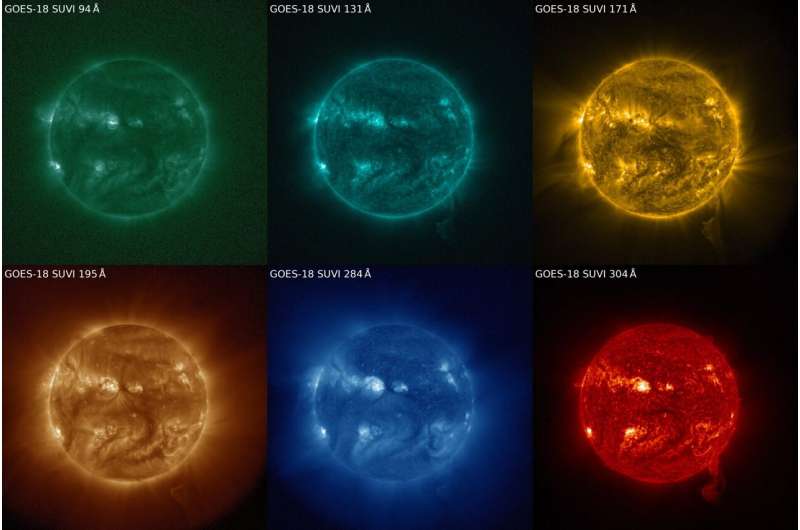NOAA shares first imagery from GOES-18 SUVI instrument

The Solar Ultraviolet Imager, or SUVI, onboard NOAA's GOES-18 satellite, which launched on March 1, 2022, began observing the sun on June 24, 2022. SUVI monitors the sun in the extreme ultraviolet portion of the electromagnetic spectrum.
The sun's upper atmosphere, or solar corona, consists of extremely hot plasma, which is ionized gas. This plasma interacts with the sun's powerful magnetic field, generating bright loops of material that can be heated to millions of degrees. Outside hot coronal loops, there are cooler regions called filaments which can erupt and become a key source of space weather when the sun is active. Filaments and active regions sometimes produce coronal mass ejections (CMEs), hurtling huge tangled clouds of plasma and magnetic field out into the solar system.
The sun's 11-year activity cycle is ramping back up, meaning phenomena such as CMEs and solar flares are increasing in frequency. GOES-18's SUVI captured a CME on July 10, 2022, which can be seen in the bottom right quadrant of the sun in the animation.
The solar corona is so hot that it is best observed with X-ray and extreme-ultraviolet (EUV) cameras. Various elements emit light at specific EUV and X-ray wavelengths depending on their temperature, so by observing in several different wavelengths, a picture of the complete temperature structure of the corona can be made. The GOES-18 SUVI observes the sun in six EUV channels, as seen in the image above. The clearest depiction of the CME captured on July 10 is in the 304 Å channel (lower right). SUVI also has a large field of view, which allows scientists to observe distinctive features of the corona.
Depending on the size and the trajectory of solar eruptions, the possible effects to near-Earth space and Earth's magnetosphere can cause geomagnetic storms, which can disrupt power utilities and communication and navigation systems. These storms may also cause radiation damage to orbiting satellites and the International Space Station.
GOES-18 is currently undergoing post-launch testing and checkout of its instruments and systems. After GOES-18 is assigned the operational role as NOAA's GOES West satellite in early 2023, SUVI observations will help NOAA's Space Weather Prediction Center provide early warning to electric power companies, telecommunication providers, and satellite operators.
Data from GOES-18 during the post-launch testing phase should be considered preliminary and non-operational.
Provided by NOAA Headquarters




















